
We have been exploring vectors and vector operations in three-dimensional space, and we have developed equations to describe lines, planes, and spheres. In this section, we use our knowledge of planes and spheres, which are examples of three-dimensional figures called surfaces, to explore a variety of other surfaces that can be graphed in a three-dimensional coordinate system.
The first surface we’ll examine is the cylinder. Although most people immediately think of a hollow pipe or a soda straw when they hear the word cylinder, here we use the broad mathematical meaning of the term. As we have seen, cylindrical surfaces don’t have to be circular. A rectangular heating duct is a cylinder, as is a rolled-up yoga mat, the cross-section of which is a spiral shape.
In the two-dimensional coordinate plane, the equation
describes a circle centered at the origin with radius
In three-dimensional space, this same equation represents a surface. Imagine copies of a circle stacked on top of each other centered on the z-axis ([link]), forming a hollow tube. We can then construct a cylinder from the set of lines parallel to the z-axis passing through circle
in the xy-plane, as shown in the figure. In this way, any curve in one of the coordinate planes can be extended to become a surface.

A set of lines parallel to a given line passing through a given curve is known as a cylindrical surface, or cylinder. The parallel lines are called rulings.
From this definition, we can see that we still have a cylinder in three-dimensional space, even if the curve is not a circle. Any curve can form a cylinder, and the rulings that compose the cylinder may be parallel to any given line ([link]).
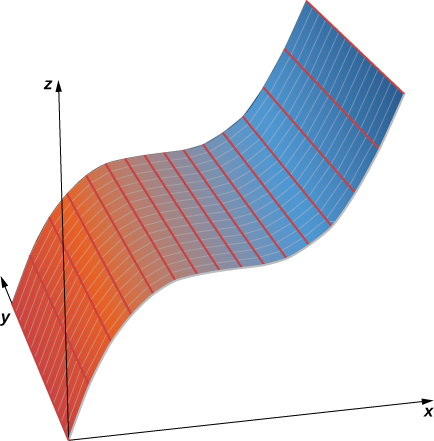
Sketch the graphs of the following cylindrical surfaces.
can take on any value without limit. Therefore, the lines ruling this surface are parallel to the y-axis. The intersection of this surface with the xz-plane forms a circle centered at the origin with radius
(see the following figure).
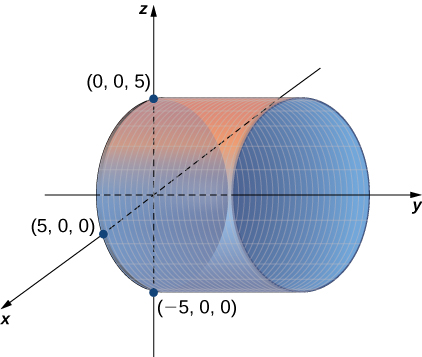
and
so none of the variables can vary arbitrarily. The easiest way to visualize this surface is to use a computer graphing utility (see the following figure).
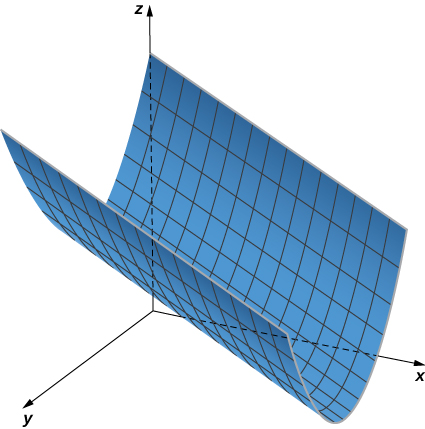
(see the following figure).
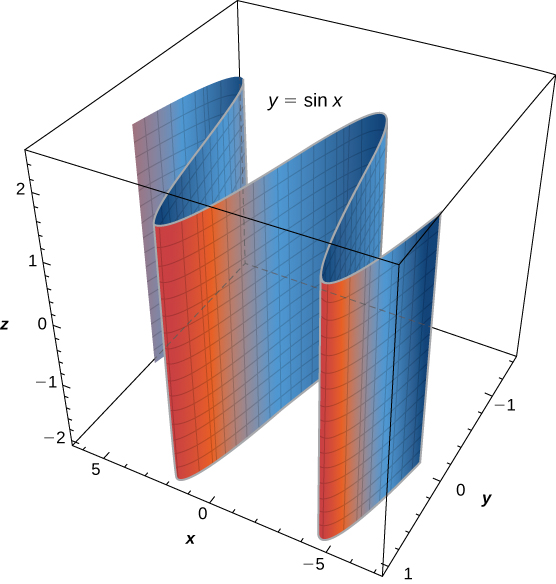
Sketch or use a graphing tool to view the graph of the cylindrical surface defined by equation
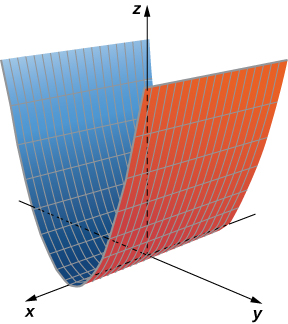
The variable
can take on any value without limit.
When sketching surfaces, we have seen that it is useful to sketch the intersection of the surface with a plane parallel to one of the coordinate planes. These curves are called traces. We can see them in the plot of the cylinder in [link].
The traces of a surface are the cross-sections created when the surface intersects a plane parallel to one of the coordinate planes.
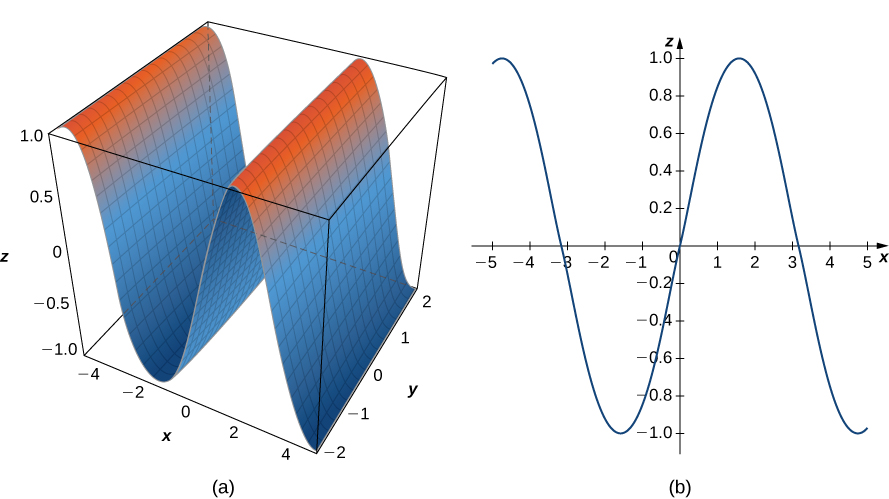
Traces are useful in sketching cylindrical surfaces. For a cylinder in three dimensions, though, only one set of traces is useful. Notice, in [link], that the trace of the graph of
in the xz-plane is useful in constructing the graph. The trace in the xy-plane, though, is just a series of parallel lines, and the trace in the yz-plane is simply one line.
Cylindrical surfaces are formed by a set of parallel lines. Not all surfaces in three dimensions are constructed so simply, however. We now explore more complex surfaces, and traces are an important tool in this investigation.
We have learned about surfaces in three dimensions described by first-order equations; these are planes. Some other common types of surfaces can be described by second-order equations. We can view these surfaces as three-dimensional extensions of the conic sections we discussed earlier: the ellipse, the parabola, and the hyperbola. We call these graphs quadric surfaces.
Quadric surfaces are the graphs of equations that can be expressed in the form
When a quadric surface intersects a coordinate plane, the trace is a conic section.
An ellipsoid is a surface described by an equation of the form
Set
to see the trace of the ellipsoid in the yz-plane. To see the traces in the y- and xz-planes, set
and
respectively. Notice that, if
the trace in the xy-plane is a circle. Similarly, if
the trace in the xz-plane is a circle and, if
then the trace in the yz-plane is a circle. A sphere, then, is an ellipsoid with
The trace of an ellipsoid is an ellipse in each of the coordinate planes. However, this does not have to be the case for all quadric surfaces. Many quadric surfaces have traces that are different kinds of conic sections, and this is usually indicated by the name of the surface. For example, if a surface can be described by an equation of the form
then we call that surface an elliptic paraboloid. The trace in the xy-plane is an ellipse, but the traces in the xz-plane and yz-plane are parabolas ([link]). Other elliptic paraboloids can have other orientations simply by interchanging the variables to give us a different variable in the linear term of the equation
or
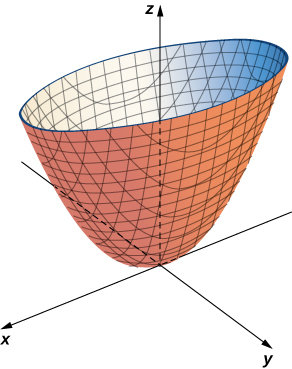
Describe the traces of the elliptic paraboloid
To find the trace in the xy-plane, set
The trace in the plane
is simply one point, the origin. Since a single point does not tell us what the shape is, we can move up the z-axis to an arbitrary plane to find the shape of other traces of the figure.
The trace in plane
is the graph of equation
which is an ellipse. In the xz-plane, the equation becomes
The trace is a parabola in this plane and in any plane with the equation
In planes parallel to the yz-plane, the traces are also parabolas, as we can see in the following figure.
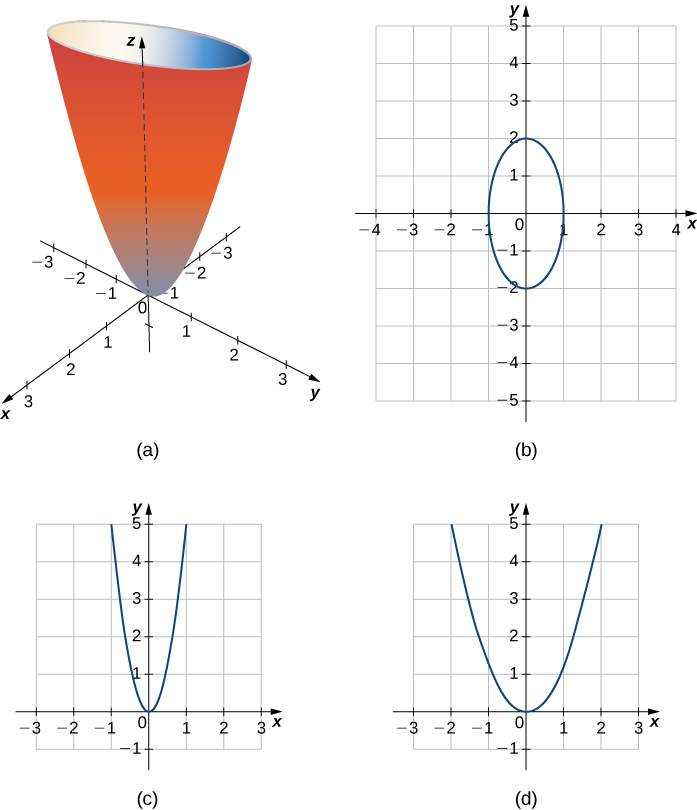
A hyperboloid of one sheet is any surface that can be described with an equation of the form
Describe the traces of the hyperboloid of one sheet given by equation
The traces parallel to the xy-plane are ellipses and the traces parallel to the xz- and yz-planes are hyperbolas. Specifically, the trace in the xy-plane is ellipse
the trace in the xz-plane is hyperbola
and the trace in the yz-plane is hyperbola
(see the following figure).* * *
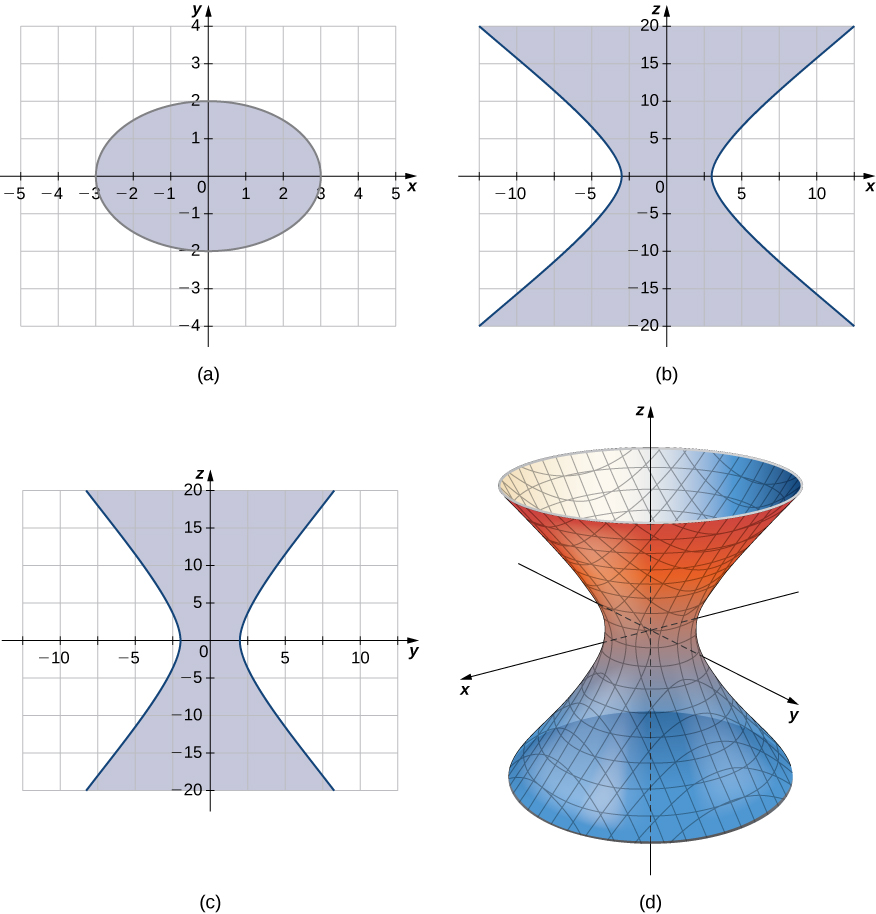
To find the traces in the coordinate planes, set each variable to zero individually.
Hyperboloids of one sheet have some fascinating properties. For example, they can be constructed using straight lines, such as in the sculpture in [link](a). In fact, cooling towers for nuclear power plants are often constructed in the shape of a hyperboloid. The builders are able to use straight steel beams in the construction, which makes the towers very strong while using relatively little material ([link](b)).
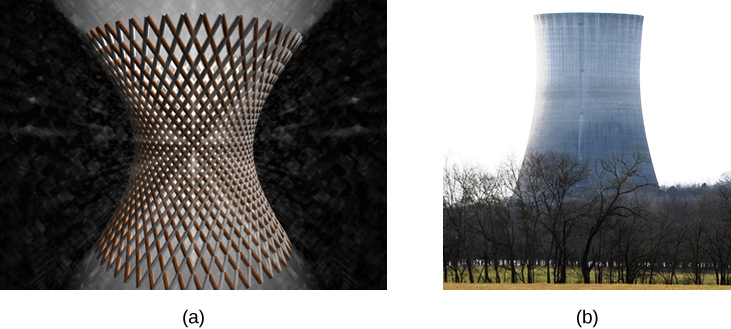
Energy hitting the surface of a parabolic reflector is concentrated at the focal point of the reflector ([link]). If the surface of a parabolic reflector is described by equation
where is the focal point of the reflector?

Since z is the first-power variable, the axis of the reflector corresponds to the z-axis. The coefficients of
and
are equal, so the cross-section of the paraboloid perpendicular to the z-axis is a circle. We can consider a trace in the xz-plane or the yz-plane; the result is the same. Setting
the trace is a parabola opening up along the z-axis, with standard equation
where
is the focal length of the parabola. In this case, this equation becomes
or
So p is
m, which tells us that the focus of the paraboloid is
m up the axis from the vertex. Because the vertex of this surface is the origin, the focal point is
Seventeen standard quadric surfaces can be derived from the general equation
The following figures summarizes the most important ones.
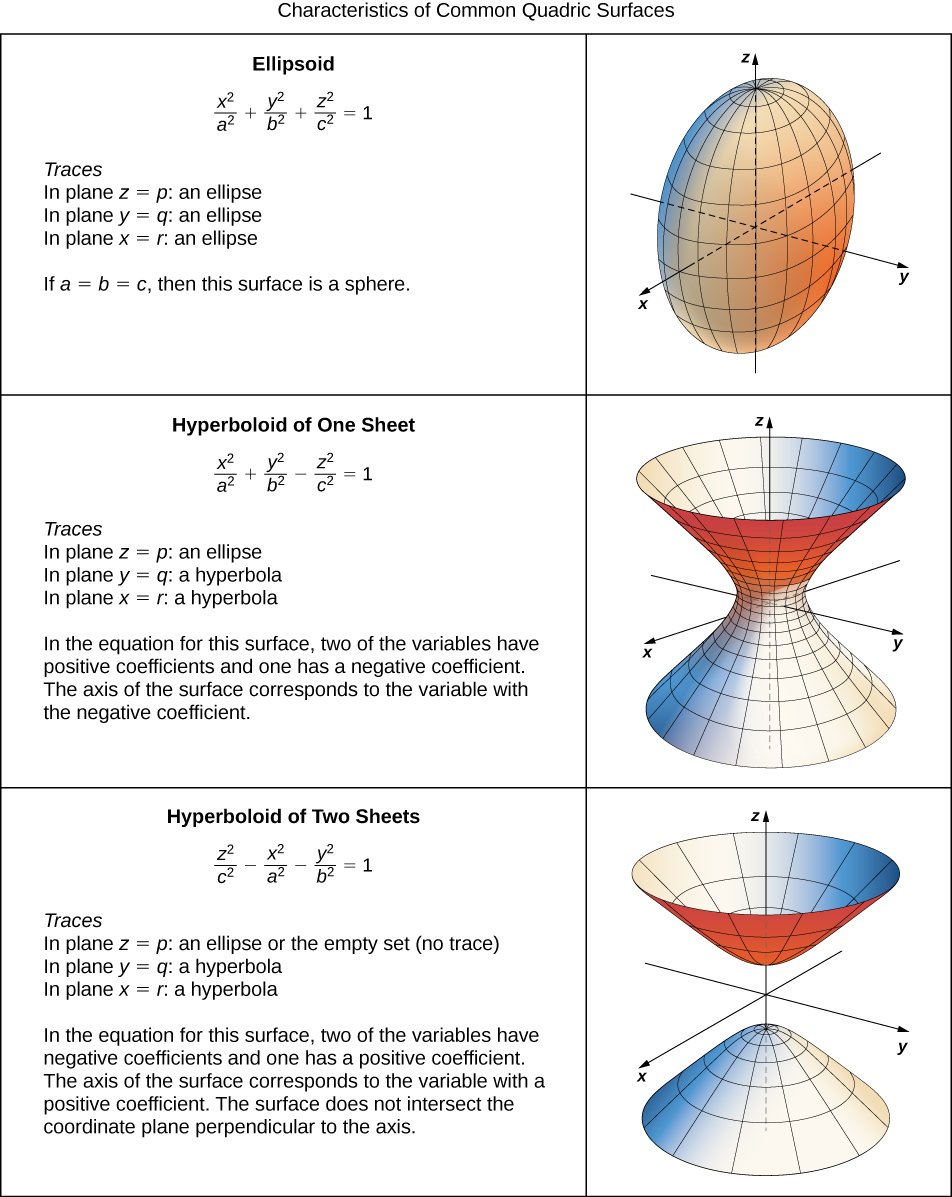
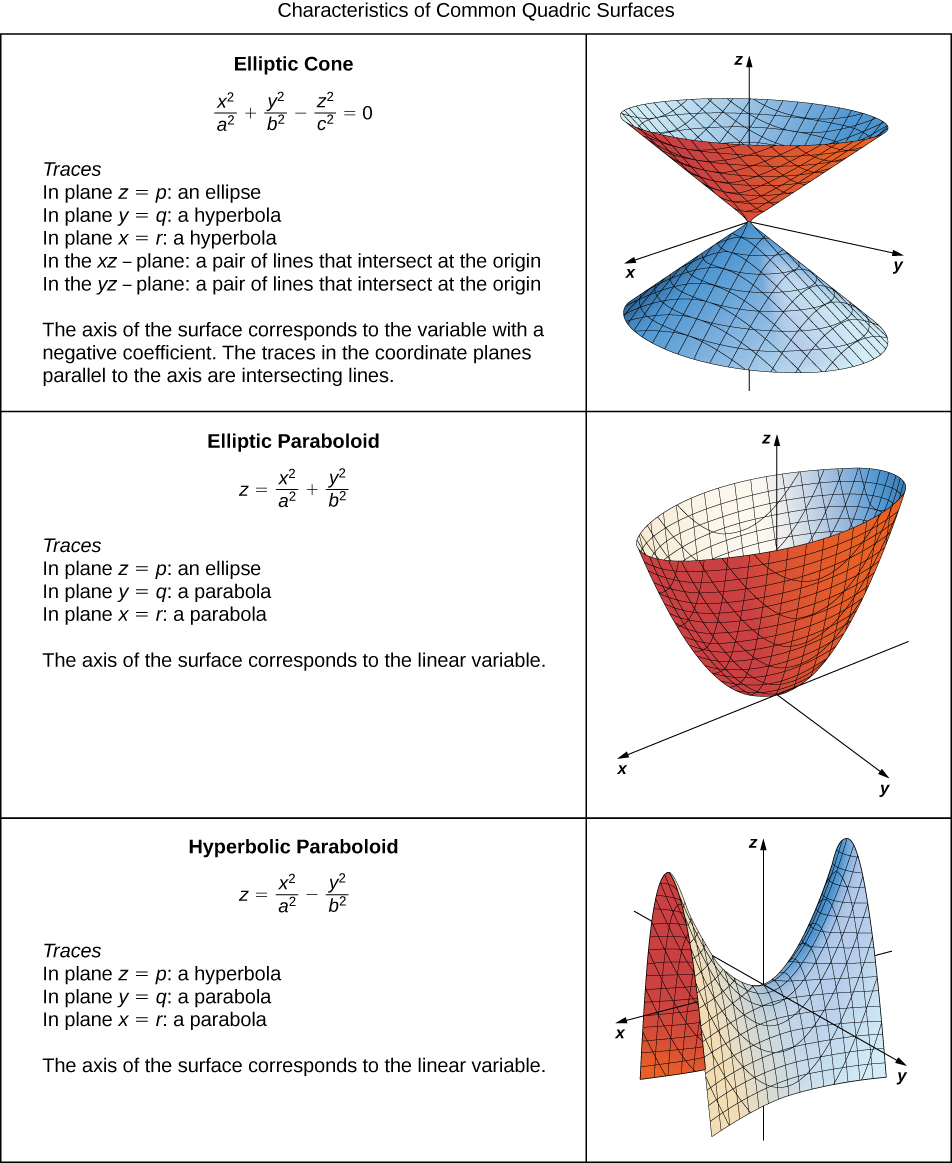
Identify the surfaces represented by the given equations.
and
terms are all squared, and are all positive, so this is probably an ellipsoid. However, let’s put the equation into the standard form for an ellipsoid just to be sure. We have
Dividing through by 144 gives
So, this is, in fact, an ellipsoid, centered at the origin.
term is raised only to the first power, so this is either an elliptic paraboloid or a hyperbolic paraboloid. We also note there are
terms and
terms that are not squared, so this quadric surface is not centered at the origin. We need to complete the square to put this equation in one of the standard forms. We have
This is an elliptic paraboloid centered at
Identify the surface represented by equation
Hyperboloid of one sheet, centered at
Look at the signs and powers of the
terms.
respectively.
For the following exercises, sketch and describe the cylindrical surface of the given equation.
[T]
The surface is a cylinder with the rulings parallel to the y-axis.* * *
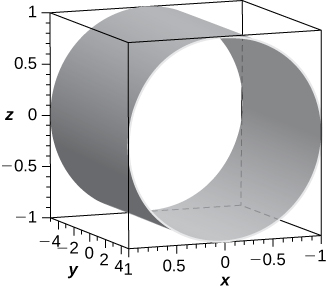
[T]
[T]
The surface is a cylinder with rulings parallel to the y-axis.* * *
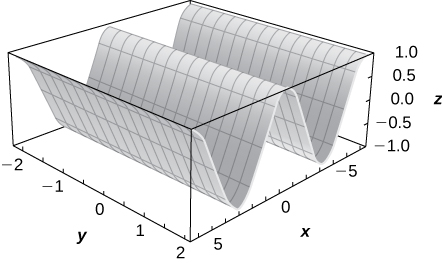
[T]
[T]
The surface is a cylinder with rulings parallel to the x-axis.* * *
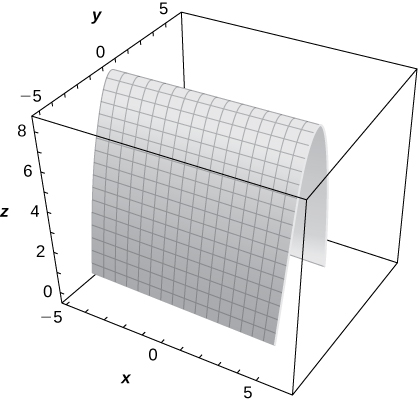
[T]
For the following exercises, the graph of a quadric surface is given.
a. Cylinder; b. The x-axis
a. Hyperboloid of two sheets; b. The x-axis
For the following exercises, match the given quadric surface with its corresponding equation in standard form.
Hyperboloid of two sheets
b.
Ellipsoid
Elliptic paraboloid
d.
Hyperbolic paraboloid
Hyperboloid of one sheet
a.
Elliptic cone
For the following exercises, rewrite the given equation of the quadric surface in standard form. Identify the surface.
hyperboloid of one sheet with the x-axis as its axis of symmetry
hyperboloid of two sheets with the y-axis as its axis of symmetry
hyperbolic paraboloid with the y-axis as its axis of symmetry
ellipsoid
elliptic cone with the z-axis as its axis of symmetry
elliptic paraboloid with the x-axis as its axis of symmetry
For the following exercises, find the trace of the given quadric surface in the specified plane of coordinates and sketch it.
[T]
Parabola
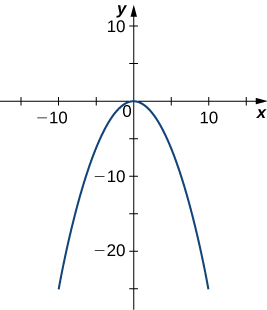
[T]
[T]
Ellipse

[T]
[T]
Ellipse
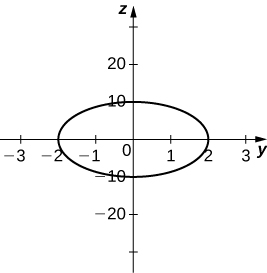
[T]
Use the graph of the given quadric surface to answer the questions.
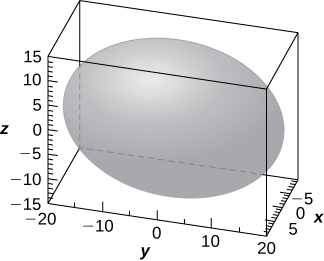
or
—corresponds to the graph?
a. Ellipsoid; b. The third equation; c.
Use the graph of the given quadric surface to answer the questions.
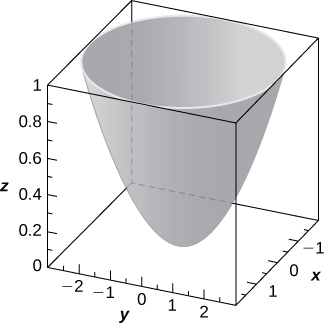
—corresponds to the graph above?
For the following exercises, the equation of a quadric surface is given.
a.
b. Cylinder centered at
with rulings parallel to the y-axis
a.
b. Hyperboloid of one sheet centered at
with the z-axis as its axis of symmetry
a.
b. Elliptic cone centered at
with the z-axis as its axis of symmetry
Write the standard form of the equation of the ellipsoid centered at the origin that passes through points
and
Write the standard form of the equation of the ellipsoid centered at point
that passes through points
and
Determine the intersection points of elliptic cone
with the line of symmetric equations
and
Determine the intersection points of parabolic hyperboloid
with the line of parametric equations
where
Find the equation of the quadric surface with points
that are equidistant from point
and plane of equation
Identify the surface.
elliptic paraboloid
Find the equation of the quadric surface with points
that are equidistant from point
and plane of equation
Identify the surface.
If the surface of a parabolic reflector is described by equation
find the focal point of the reflector.
Consider the parabolic reflector described by equation
Find its focal point.
Show that quadric surface
reduces to two parallel planes.
Show that quadric surface
reduces to two parallel planes passing.
[T] The intersection between cylinder
and sphere
is called a Viviani curve.
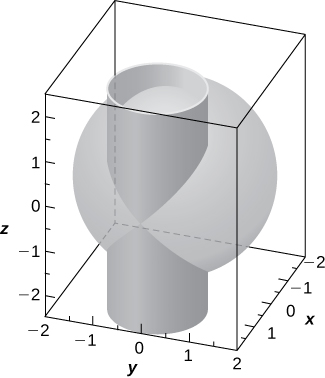
and
in terms of
a.
where
b.* * *
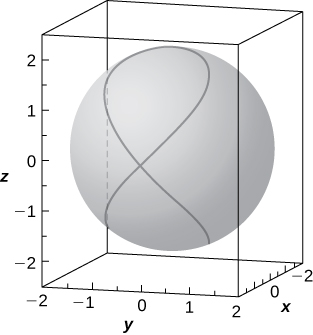
Hyperboloid of one sheet
and elliptic cone
are represented in the following figure along with their intersection curves. Identify the intersection curves and find their equations (Hint: Find y from the system consisting of the equations of the surfaces.)
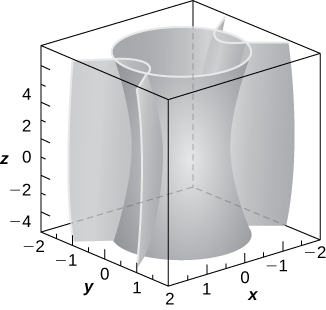
[T] Use a CAS to create the intersection between cylinder
and ellipsoid
and find the equations of the intersection curves.
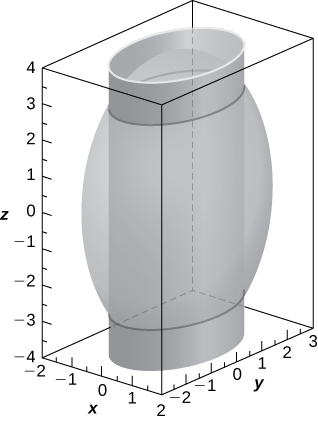
two ellipses of equations
in planes
[T] A spheroid is an ellipsoid with two equal semiaxes. For instance, the equation of a spheroid with the z-axis as its axis of symmetry is given by
where
and
are positive real numbers. The spheroid is called oblate if
and prolate for
Write the equation of the spheroid that models the cornea and sketch the surface.
[T] In cartography, Earth is approximated by an oblate spheroid rather than a sphere. The radii at the equator and poles are approximately
mi and
mi, respectively.
corresponds to the equator.
that is parallel to the xy-plane. The intersection curve is called a parallel.
that passes through the z-axis. The intersection curve is called a meridian.
a.
b.* * *
 ;* * *
;* * *
c. The intersection curve is the ellipse of equation
and the intersection is an ellipse.; d. The intersection curve is the ellipse of equation
[T] A set of buzzing stunt magnets (or “rattlesnake eggs”) includes two sparkling, polished, superstrong spheroid-shaped magnets well-known for children’s entertainment. Each magnet is
in. long and
in. wide at the middle. While tossing them into the air, they create a buzzing sound as they attract each other.
[T] A heart-shaped surface is given by equation
a.* * *
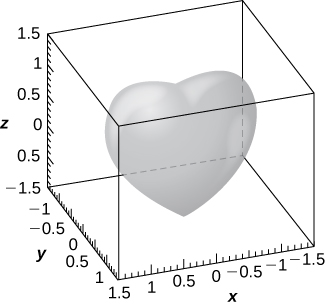
b. The intersection curve is
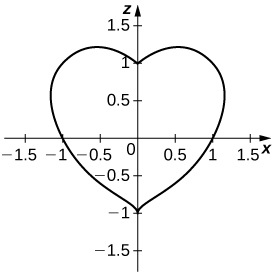
[T] The ring torus symmetric about the z-axis is a special type of surface in topology and its equation is given by
where
The numbers
and
are called are the major and minor radii, respectively, of the surface. The following figure shows a ring torus for which
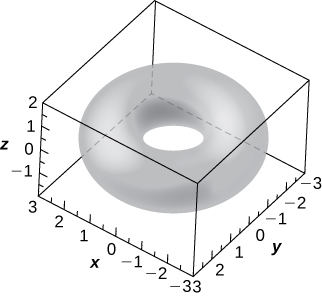
and use a CAS to graph the surface. Compare the graph with the figure given.
all traces of this surface are ellipses
traces of this surface include ellipses and intersecting lines
traces of this surface include ellipses and parabolas
traces of this surface include ellipses and hyperbolas
traces of this surface include ellipses and hyperbolas

You can also download for free at http://cnx.org/contents/9a1df55a-b167-4736-b5ad-15d996704270@5.1
Attribution: